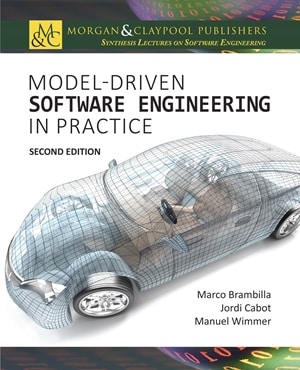![]()
GenMyModel is a cloud-based UML tool for developers and software architects. Its main force: create UML-compliant models and generate code online, from a web-browser.
GenMyModel has been boosted since its first post on modeling-language: several thousands of users have registered and the recurrent feedback was decisive to build the features. Thomas Legrand updates on the status of the project
After a first beta released in 2013, proving that UML models can be edited and stored in the cloud, the real-time collaboration is in the testing phase and will be soon available. After 3 years of research and development and a phd in progress*, GenMyModel is making software modeling more collaborative. The collaborative features will include version management and group management. It will allow teams to design their systems together and interact through the models.
With its new web-based experience, the collaboration and online code generators, the ambition of GenMyModel is to create the world’s largest modeling platform.
Try GenMyModel: UML Online Tool.
Beta version
A first beta version has been released in october 2012 with the basic features. The set of features is continuously extended and contains now:
– Class diagram. With easy drag&drop, dual view diagram/model with the Project Explorer, the panel property and much more. Very close to desktop standards.
– Use case diagram
– Java and SQL code generators
– Code push and round-trip to GitHub (a good video with Codenvy illustrates how to push/pull and edit the generated code)
– Image export: JPEG, SVG
– Documentation report as PDF
– Model export as XMI files (Ecore format, can be used in Eclipse/EMF)
– Web page for the description of public projects (ex: Online Shopping Cart made with GenMyModel)
Roadmap
The feedback is very important to improve GenMyModel and until now, the community made most of the decisions. The insights from beta testers allow the team to make the right decisions, and more importantly, bring the beta testers into the development process. The next minor release is scheduled for August. The packaging and resizing will be provided.
Other features are still submitted to beta tester’s vote to set the priorities in the roadmap:
– new code generators
– code generator customization
– other diagrams: activity, sequence
The next significant milestone is planned for October 2013 with the real-time collaborative modeling. Experts can help the development team for the testing phase; a free access to the release candidate can be provided, please contact the team at: team{at}genmymodel.com.
Reference
(1) Michel Dirix. Awareness in Computer-Supported Collaborative Modelling. Application to GenMyModel
FNR Pearl Chair. Head of the Software Engineering RDI Unit at LIST. Affiliate Professor at University of Luxembourg. More about me.







Do you think it can save UML? UML is declining while IT engineers say they need more modeling. The tool is awesome but I may have doubts, even if there’s a common need. So many attemps have been made towards a modeling platforms…so many failures…
Even for a web-based modeler/platform, isn’t it too late?
Can I ask you where did you read that IT Engineers say they need more modeling? I agree that the success of any language also depends on the tools available for that language.
We have been needing this for quite a while.
Others offered this first, with no extensive community adoption
http://en.bpmn-community.org/
Few youngsters do models. Those that do, post-process them through something to make diagrams look as drawn on a napkin – showing they are embarrassed of making models.
This is a complete failure of communication from the modelling community to the new engineers.
I understand, though: it was exceedingly exhausting to fight 4amigos, Rational, IBM, the 2.0 to 2.x debacle, the whole MOF/DSL vs. UML, BOCA, EDOC, EAI, ebXML, …
All the while the industry even publicly had to acknowledge that it was driven by man/hours, and not productivity, so even the Eclipse sponsoring of modeling was a smoke-screen on the then still SUN java initiative.
I mean: unless there is proper education, no tools will make a difference, no matter how outstanding they are.
We can do without the real-time. Actually, I can not care less – but I understand it looks fancy, as is i.e. WebRTC interoperability demos between Firefox and Google- actually, if its is about collaboratively messing on a diagram many at a time, you may as well jump on that wagon.
What we NEED is (to put it in layman’s terms) GIT/Mercurial kind of pulling/pushing model versions, promoting them over the development organization hierarchy : an model versioning system reflecting the actual organization of modeling work units. Something like “SVN”, able to compare and merge at the level of meta-model feature value.
A potential show-stopper impedance mismatch with the latest generations of engineers, and I mean the generation that shall enjoy the new ubiquitous ECMAscript/JavaScript,
is that the conventional teaching of UML modelling of classifiers and instances is so rigid, that it hardly fits the prototype oriented, slot based nature of ECMAscript.
Indeed, some of the JavaScript community endeavors in making Class-based systems with JavaScript. I believe it’s an industry attempt to reuse previous training in new technologies.
Hats off to the language authors, because indeed it can be done (SUN’s SELF, and others prove it, a decade earlier).
In any case, the impedance mismatch, as perceived by trainees, is there, and therefore their adoption of UML is minimal.
So, may be there are ways to fuse instances and classifiers modelling, and that can be tough to new engineers … or … was that possibility lost when UML infra/super structure separation was destroyed by IBM ?
I appreciate your way of explaining this UML cloud tool. Thank you!
great ap
iwould appreciate a sysml modeling tool
“- other diagrams: activity, sequence”? when they’ll be publish?
many thanks for this free version
Eric Fricot
french teacher
Yes, would be intersting to have a SysML collaborative tool!